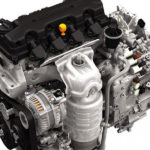The 1.3-liter 16-valve Suzuki G15A engine was produced in Japan from 1991 to 2002 and was installed on the second and third generation of the Cultus models popular in the local market. Then this power unit was sent to third world countries, where it is still being assembled.
Engines of the G-series: G10A, G13B, G13BA, G13BB, G15A, G16A, G16B.
Specifications
| Production years | 1991-2002 |
| Displacement, cc | 1493 |
| Fuel system | distributed injection |
| Power output, hp | 91 – 97 |
| Torque output, Nm | 123 – 129 |
| Cylinder block | aluminum R4 |
| Block head | aluminum 16v |
| Cylinder bore, mm | 75 |
| Piston stroke, mm | 84.5 |
| Compression ratio | 10.0 |
| Features | SOHC |
| Hydraulic lifters | no |
| Timing drive | belt |
| Phase regulator | no |
| Turbocharging | no |
| Recommended engine oil | 5W-30 |
| Engine oil capacity, liter | 3.3 |
| Fuel type | petrol |
| Euro standards | EURO 2/3 |
| Fuel consumption, L/100 km (for Suzuki Cultus 1997) — city — highway — combined |
6.8 4.7 5.4 |
| Engine lifespan, km | ~320 000 |
| Weight, kg | 87 (without attachments) |
The engine was installed on:
- Suzuki Cultus 2 (SF) in 1991 – 1995; Cultus 3 (SY) in 1995 – 2002.
Disadvantages of the Suzuki G15A engine
- This is a simple and reliable motor, but its aluminum block and cylinder head are afraid of overheating;
- With regular overheating, cracks appear very quickly in the cooling jacket;
- The timing belt often bursts before the regulations, but it’s good that the valves do not bend here;
- After 150,000 km, valve stem seals wear out and lubricant consumption appears;
- There are no hydraulic lifters here and every 30,000 km you will have to adjust the valve clearances.






